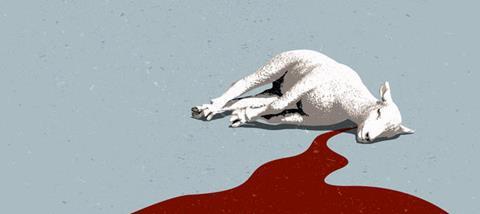
My teenage daughter had returned from a foreign school trip and was regaling us with her adventures. She described several experiences before hitting us with: ‘And I took part in a ritual slaughter.’ I decided to remain calm and let her tell me about it.
The group had been helping renovate a school in rural Mongolia, and the villagers wanted to give them a feast to express their thanks. As honoured guests they were invited to share in the slaughter of the goat for their meal. They sat down on an expensive rug with an elder who had a knife and a bowl. He stroked the goat, talked to it quietly until it was calm enough to lie on the rug unrestrained, then put the bowl beside it and made a small incision in its neck. The goat didn’t even bleat. It just lay there, being stroked and falling asleep as the bowl filled with blood. Gradually it stopped breathing.
THE REALITY OF ANIMAL SACRIFICE
When we think of animal sacrifice, we tend to conjure up pictures of screaming, terrified livestock, knives, slashing and blood. But Old Testament sacrifices were very similar to the killing of the goat witnessed by my daughter. Of course, there was still plenty of blood and they would not have taken place in a quiet gathering – the Temple was a busy place – but the animals were killed in the same humane way.
Most sacrificed animals were killed by the person who brought them. They may have known the animal well – if they were farmers they had probably helped deliver it and watched it grow. During the journey, they would have kept it away from other animals to make sure it didn’t become blemished. The easiest way of doing so was to keep it in their own tents, so it was
almost like a pet. Later Rabbinic law said that if an animal was killed painfully, it wasn’t kosher. Slitting the throat can be virtually painless with a sharp knife, and this was the kindest way to kill an animal before the invention of guns.
I like to imagine that meat grows inside supermarket packaging – I find animal slaughter somewhat horrifying – however, I can see that Jewish sacrifices involved minimal suffering and were in line with the Old Testament laws against animal cruelty. As a modern Western reader, ‘sacrifice’ makes me think of a victim and punishment, but an ancient Jewish reader would have regarded it differently: as a gift from the person making the offering.
JESUS: THE GIFT
What does the New Testament mean when it describes Jesus’ death as a sacrifice for sin? We know that Jesus
bore the consequences of our sin (as foreseen in Isaiah 53 – see last month’s ‘Doctrine Detective’), but we shouldn’t confuse that with the Jewish concept of sacrifice which represents reconciliation, not punishment. The word ‘atonement’ was invented by William Tyndale who couldn’t find a way of denoting this concept in English, so merged three words: ‘at-one-ment’. It indicates the reuniting of people or groups who were estranged. Sin – the barrier between God and humanity – was removed by sacrifice.
Paul elaborated on this in Colossians 1:20-22: ‘You were alienated from God and were enemies in your minds because of your evil behaviour. But now he has reconciled you by Christ’s physical body through death…’ In 2 Corinthians 5:19-21 he defined what kind of sacrifice was needed: ‘God was reconciling the world to himself in Christ, not counting people’s sins against them…God made him who had no sin to be sin for us, so that in him we might become the righteousness of God’ (2 Corinthians 5:19-21, my italics). Jesus was our sin offering.
JESUS: THE SIN OFFERING
Sin offerings were central to Jewish religion – they reminded a Jew to say sorry to God in order to be reconciled to him – so this imagery was an effective way of explaining the significance of Jesus’ death. And they were different to other offerings. Most offerings were celebrated with a party: you had to eat the sacrificed animal immediately, so you would invite family and friends to help you. In contrast, sin offerings could only be eaten by priests. By accepting and eating your offering on God’s behalf, the priests demonstrated that your relationship with God was healed. That’s why Moses became so angry when, on one occasion, the priests didn’t eat a sin offering (Leviticus 10:16-17).
It’s a mistake to think of a sin offering only in connection with the Day of Atonement. On this unique day, a sin offering was burnt outside the city – a parallel with Jesus who was crucified outside the city (Hebrews 13:11-12). But all the other normal sin offerings were also related to Jesus’ sacrifice. These sin offerings and other sacrifices tells us that the cross reunites us with God.
In the sacrificial system, God didn’t require a huge feast – any small offering was sufficient. If you were poor, you could bring a couple of doves or even a small baked bun; they were equally acceptable for atonement, even for the same sin (see Leviticus 5:7-13). This showed that the offering wasn’t punishment – like paying a fine; it was a gift to show God that you were sorry. God was like the prodigal’s father who longed for any indication, however small, that his son wanted to be reconciled.
GOD DIDN’T REQUIRE A HUGE FEAST – ANY SMALL OFFERING WAS SUFFICIENT
PUNISHMENT AND MERCY
The image of sacrifice shows that the cross is not just a judicial transaction. It is about a father who longs to gather his lost children, a shepherd who goes looking for stray sheep, and a husband who forgives the wife who has strayed. If we put too much emphasis on punishment for sins, we forget God’s mercy and forgiveness. After all, if Jesus paid the price for all our sins, then there is nothing for God to forgive or be merciful about. No single understanding of the cross can convey its full meaning, and attempting to rely on only one explanation will lead us astray.
I recoil from images of animal sacrifice. But neglecting to understand the cross as sacrifice would leave a huge gap in my theology. Jesus’ sacrifice, seen through the eyes of a first-century reader, unveils a glimpse of the depth of God’s love. This was not just a generous gift, but an atonement offering – a desperate plea by a bereft father who longs to reunite with his children.




























